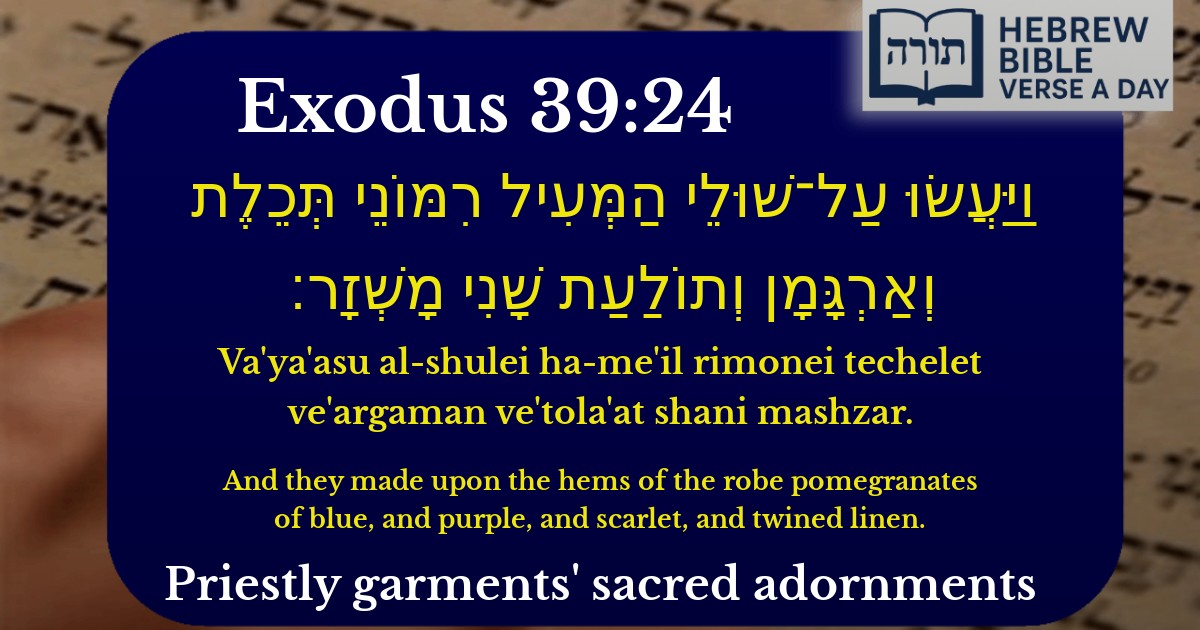Join Our Newsletter To Be Informed When New Videos Are Posted
Join the thousands of fellow Studends who rely on our videos to learn how to read the bible in Hebrew for free!
Hebrew Text
וַיַּעֲשׂוּ עַל־שׁוּלֵי הַמְּעִיל רִמּוֹנֵי תְּכֵלֶת וְאַרְגָּמָן וְתוֹלַעַת שָׁנִי מָשְׁזָר׃
English Translation
And they made upon the hems of the robe pomegranates of blue, and purple, and scarlet, and twined linen.
Transliteration
Va'ya'asu al-shulei ha-me'il rimonei techelet ve'argaman ve'tola'at shani mashzar.
Hebrew Leining Text
וַֽיַּעֲשׂוּ֙ עַל־שׁוּלֵ֣י הַמְּעִ֔יל רִמּוֹנֵ֕י תְּכֵ֥לֶת וְאַרְגָּמָ֖ן וְתוֹלַ֣עַת שָׁנִ֑י מׇשְׁזָֽר׃
Parasha Commentary
📚 Talmud Citations
This verse is quoted in the Talmud.
📖 Yoma 72a
The verse is discussed in relation to the garments of the High Priest, particularly the robe (me'il) and its adornments, emphasizing the significance of the pomegranates and colors in the priestly service.
📖 Zevachim 88b
The verse is referenced in a discussion about the materials and craftsmanship involved in making the priestly garments, highlighting the importance of the details described in the verse.


The Pomegranates on the Kohen Gadol's Robe
The verse (Shemot 28:33) describes the decorative pomegranates made of blue (תכלת), purple (ארגמן), and scarlet (תולעת שני) wool, along with twisted linen (משזר), which adorned the hem of the me'il (robe) of the Kohen Gadol. This detail is rich with symbolic meaning according to Orthodox Jewish commentators.
Materials and Their Symbolism
Symbolism of the Pomegranates
The pomegranates were not merely decorative. The Talmud (Zevachim 88b) states that they served as a reminder of the mitzvot, as a pomegranate is filled with seeds, symbolizing that even the simplest Jew is "full of mitzvot like a pomegranate [is full of seeds]." Additionally, the juxtaposition of the pomegranates with the golden bells (mentioned in the next verse) teaches that Torah study (symbolized by the sound of the bells) must be accompanied by good deeds (symbolized by the pomegranates).
Structural Details
The me'il was entirely woven from תכלת (blue wool), making it unique among the priestly garments (Rashi, Shemot 28:31). The pomegranates and bells alternated along the hem, as derived from the phrasing in the Torah (Rambam, Hilchot Klei HaMikdash 9:4). This arrangement ensured that the Kohen Gadol would be heard as he moved, preventing him from entering the Holy of Holies unnoticed (Shemot 28:35).